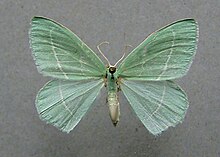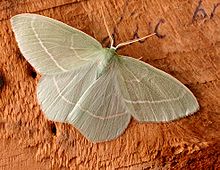|
Hemistola chrysoprasaria
Hemistola chrysoprasaria, the small emerald, is a moth of the family Geometridae. The species can be found in all Europe including the Iberian Peninsula and Russia East to the Ural Mountains, North Africa, Asia Minor, Transcaucasia and the mountains of Eastern Asia (Russian Far East, Siberia), (Amur, Ussuri) and China Tian Shan (as form lissas) DescriptionThe wingspan is 28–32 mm. Both forewings and hindwings are light-green coloured, but fade with increasing life span to yellow-green to yellow-white. There is an outer and a fainter inner, slightly curved and continuous, white cross line on the front wings. The inner (antemedian) is strongly curved and usually with two small, slight teeth directed distad, the outer (postmedian) is nearly parallel with distal margin, not dentate. The outer line continues on the hindwing. There is no discal stain. The antennae of the males are slightly combed, those of females short ciliate. In Amur and Ussuri the specimens are often large and with the lines rather widely separated. Lissas differs in the shape of the hindwing, which is rounded instead of elbowed[1][2]  The fresh egg is green color and discolours into dark tints just before hatching. It is very flattened on both sides. The egg pole is lateral The caterpillars show a variable cryptic coloration. They are green at first, then brownish during hibernation and green again in spring. The pupa has a green colour. BiologyThe moths fly in one generation from June to August. [1]. The larvae feed on Clematis vitalba. Habitats include edges of woods, hedges areas as well as gardens and parks. It prefers warm slopes. Subspecies
Sister speciesAllopatric with Hemistola siciliana (Prout, 1935) (Middle and South Italy, Sicily) Notes
References
External linksWikimedia Commons has media related to Hemistola chrysoprasaria.
|
||||||||||||||||||||||||||||
Portal di Ensiklopedia Dunia

